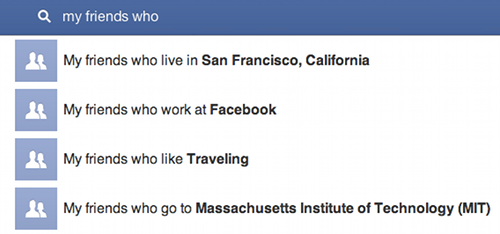Blog posts tagged Facebook
What Facebook Graph Search means for business

Facebook Graph Search in action
Facebook took a big step towards becoming a social search engine this week when it announced Graph Search, a tool to help users find content on the social network.
As Graph Search becomes more widely available, it could have big implications for how businesses use Facebook.
What is Graph Search?
Facebook defines its graph as being the map of relationships between everyone using the service. The graph is huge. It contains data about more than a billion people, over 240 billion photos and information about over a trillion connections.
Graph Search is Facebook's first real attempt to provide anything more than basic search tools. The company does a good job of explaining it in the official press release:
"Graph Search and web search are very different. Web search is designed to take a set of keywords (for example: “hip hop”) and provide the best possible results that match those keywords. With Graph Search you combine phrases (for example: "my friends in New York who like Jay-Z") to get that set of people, places, photos or other content that's been shared on Facebook. We believe they have very different uses."
Graph Search results will take into account the connections and privacy settings of individual users, so when you search you'll only be able to see things you'd be able to see elsewhere on Facebook.
The function isn't widely available yet, but if you want to try it you can join the waiting list here.
What can I find with Graph Search?
Graph Search is currently focused on helping users find four main things: people, places, photos and interests. Graph Search examples suggested by Facebook include:
- 'Restaurants in London my friends have been to'
- 'People who like cycling and are from my home town'
- 'Photos of my friends in New York'
But make no mistake, this is just the start of Facebook's efforts to do more with its most valuable asset - the graph - and you can expect this to evolve into a really powerful tool over the next few months.
What does Graph Search mean for businesses?
It doesn't take a great deal of imagination to see that Graph Search could significantly influence how potential customers find businesses.
Take the first bullet point above: 'restaurants in London my friends have been to'. If you run a restaurant and you're not listed on Facebook, you don't have any chance of appearing in the results, even if you have five star reviews and thousands of satisfied customers.
In simple terms, Graph Search could make it more important that you keep your company's Facebook page up-to-date and interesting.
Getting 'likes' on Facebook might become more important too, as Facebook may use these to determine Graph Search rankings.
Will Graph Search work in reverse?
There's obviously potential here for Facebook to let businesses use Graph Search to identify potential customers via searches like:
- 'People who like eating in central London restaurants'
- 'People who have been on holiday to the Lake District more than once'
- 'People who have recently moved to Bristol'
Sure, Facebook already offers significant targeting options to advertisers. But Graph Search has the potential to make targeting both easier and more accurate.
It remains to be seen how the site's users will respond to to all this. But there's no doubt that for Facebook itself, the graph is a valuable asset. It's how the company hopes to make big money in the years ahead.
Friday Donut tip: be careful what you share

Learn when to keep it zipped. (Image: Flickr user stev.ie)
The power and usefulness of social media has been demonstrated time and time again. In 2012, your business needs a good reason not to start tweeting or getting friendly on Facebook.
But social media makes it easy to share too much. From what you had for breakfast to edgy jokes, some things are best kept to yourself. Just ask Charlie Sheen, who mistakenly tweeted his mobile phone number to about five million people.
We recently stumbled across the Need a debit card Twitter account, which retweets photos of people's debit cards in an effort to highlight the security risk of posting these details online. And it inspired us to come up with these four tips to keep your tweets safe:
- Don't post images containing sensitive information. As well as your debit and credit cards, keep an eye out for screenshots containing private information, photos of letters and other documents, and private email addresses or telephone numbers.
- Don't publicise holidays or absences. If your office is empty for the day because you've all gone on the annual outing, that's the ideal time for crooks to strike. And it really does happen - a small survey of criminals suggested Facebook and Twitter offer rich pickings.
- Don't get into public arguments. Nobody ever wins online arguments. That was true before social media existed and it's true today. If you're involved in a discussion and it's getting out of hand, step away from the keyboard before the red mist descends. It's never pretty to see a professional company get embroiled in a petty online dispute.
- Don't bash your competitors. It's undignified and it suggests you're seriously worried about the competition. You know that old saying, 'if you can't say something nice then don't say anything'? It definitely applies in this situation.
Finally, remember the golden rule of running your company's social media accounts. If you're not sure whether you should post something, it's usually best not to. There are plenty of other things you can share without risking anything.
Previous Friday tips:



